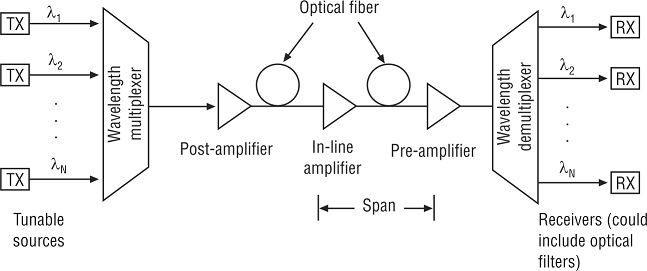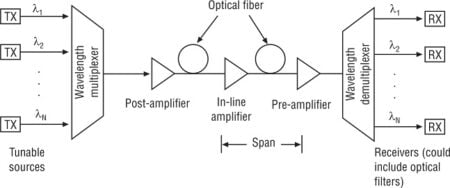Table of Contents
Wavelength Division Multiplexing
Wavelength division multiplexing (WDM) is based on the fundamental physical principle which states that many optical rays having different wavelengths can be propagated together over a common optical channel with no interference. The concept of Wavelength division multiplexing (WDM) is analogous to the basic concept of frequency division multiplexing (FDM) in which the available bandwidth of a communications channel in its frequency domain is divided into multiple sub-bands (called user channels). It implies that each user channel occupies only a part of the wide frequency spectrum.
In WDM, each user channel is recognized by an optical wavelength. Remember the relationship between the wavelength and frequency as l = c/f, which implies that shorter the wavelength of the signal, higher will be its frequency, and vice-versa. We can say that optical FDM is WDM. In optical fiber communications, each wavelength serves as a separate channel (i.e., an optical fiber). Different wavelengths are properly spaced (similar to guard band in FDM) so as to avoid any possibility of inter-channel interference.
Multiplexing | Frequency Division, Time Division

WDM technology uses multiple wavelengths on individual fiber lines to transmit information over a single fiber line using optical multiplexer. The figure shown below illustrates a conceptual difference between time division multiplexing (TDM) which uses TDM–MUX or optical TDM (which uses OTDM–MUX) and WDM that uses WDM–MUX.
TDM vs WDM

Most optical networks use a combination of TDM and WDM. In this, fixed time-slots are timedivision multiplexed onto a specific wavelength and then employ optical TDM multiplexer (OTDM MUX). It allows multiple users to share the entire capacity of one WDM wavelength. In most of the cases, a single wavelength capacity is much more than that needed by an individual user. The basic concept of WDM is to use the optical channels (frequency slots in terms of wavelength channels) to carry user data. Data transmission formats may have different analog or digital asynchronous bit rates. An optical channel is capable of carrying any type of data format. In general, WDM enables the upgradation or enhancement of information-carrying capacity of present optical networks without any addition of optical fibers. The figure shown below illustrates the principle of operation of a typical WDM system.

Principle of operation of a WDM system
As shown, WDM contains an orthogonal set of optical carriers (λ1, λ 2, … λ N) emitted by corresponding tunable optical sources (Lasers or LEDs) generating a data stream. All these optical signals are combined by an optical MUX, known as wavelength multiplexer. The power of the multiplexed optical signal can be boosted by using post optical amplifier and then transmitted simultaneously over the common optical fiber. The main function of wavelength multiplexer is to combine different optical signals (varying in wavelengths) into a continuous wavelength spectrum and launch them over the same optical fiber. A chain of optical amplifiers as post optical amplifier which is used to boost the optical power, an in-line optical amplifier which is used to compensate for the fiber attenuation, as well as a pre-amplifier for increasing the sensitivity of optical receiver are used along the optical fiber link.
An optical DEMUX, known as wavelength demultiplexer, at the receiver end separates the signals having different wavelengths and directs them to appropriate optical receivers comprising of optical filters and photodetectors. Thus, we see that there may be a requirement of several types of optical components/devices (both passive and active) for the purpose of amplification, combining, isolating different wavelength signals, and distributing to respective optical receivers.
Similar to a guard band, there is a small spacing in between the wavelengths, which reduces the non-linear effects and possible inter-channel interference in WDM. The relationship to define wavelength separation between adjacent wavelengths is given as
Wavelength Separation = \frac{Frequency separation\times (wavelength)^{2}}{speed of light}The range of wavelengths carried in the optical fiber varies. A common set of wavelengths used is mostly in the 1550-nm region (called C-band).
Features of WDM
- Capacity Upgrade: WDM is capable of enhancing the capacity of optical fiber communications networks significantly. DWDM offers almost unlimited transmission capacity.
- Transparency and Scalability: In WDM, each optical channel can carry any type of transmission signal format and scalable.
- Wavelength Switching: Wavelength-switched architecture allows reconfiguration of optical layer. Wavelength-routed telecom networks are based on rigid optical fiber infrastructure.
- Wavelength Routing and Dynamic Provisioning: The use of wavelength-sensitive optical routing devices can use wavelength as one additional dimension in designing tele-communication switches and networks.
Advantages of WDM
- In WDM, the wavelength of the channel is used for optical switching, optical routing, or dispensing each optical channel to its designated receiver. As a result, wavelength division multiple access (WDMA) network is an all-optical network.
- WDM enables leasing out an individual wavelength instead of leasing an entire fiber–optic link, thus enhancing the scope to a larger scale of its usage.
- WDM allows optical networks to increase their capacity manifold (i.e., 6000 times). For example, in DWDM, it is possible to operate one optical fiber in bit rate of the order of Tbps.
- With the deployment of tunable lasers as optical sources, and dynamic wavelength/spectrum management, WDM enables to support ‘bandwidth and quality of service (QoS) on demand’ requirements.
- Due to increase in traffic-carrying capacity with the use of WDM in optical networks, it is possible to deliver audio, video, and data channels together at high speed and at a reasonably low cost.
Applications of WDM Systems
In Wavelength division multiplexing (WDM) systems, various optical signals having different wavelengths are transmitted simultaneously using the same optical fiber after each one is modulated by independent electrical bit streams. Frequency division multiplexing (FDM) for analog channels, or time-division multiplexing (TDM) for digital channels may be used by electrical bit streams in the electrical domain before these are subjected to wavelength-division multiplexing (WDM). Each wavelength channel can carry several time-division multiplexed channels which can be further multiplexed in WDM–MUX for transmission over the common optical fiber medium. An optical demultiplexer is used at the optical receiver end of WDM communications link for segregating individual channels of the received multiplexed optical signal.
Usually, optical fibers offer very large bandwidth. WDM simply exploits this capability of optical fibers. As an instance, WDM channels carrying 100s of 10-Gbps data rate can be propagated successfully using the same fiber by reducing the inter-channel separation to be less than 100 GHz. We can say that the capacity of fiber–optic communication links can exceed 10 Tbps. Due to the availability of various optical WDM components, WDM-based systems have many applications, such as
Applications
- Point-to-point high-capacity optic–fiber links: WDM helps to increase the overall bit rate (high capacity) for long-haul (point-to-point) optical fiber communication links which serves the core or backbone of a wide area telecommunication network. If N channels having equal bit rates are multiplexed using optical multiplexers and then transmitted over the same fiber, then the overall capacity increases (or is multiplied) by a factor of N.
- LAN using WDM: A broadcast star topology may be generally employed to multiplex several optical channels at the LAN level, e.g., Lambdanet.
- MAN and WAN using WDM: A MAN is formed by connecting several LANs in a ring topology using passive wavelength routers. A WAN can be formed by connecting several MANs in which different nodes are usually interconnected following a mesh topology that uses dynamically configurable optical cross-connect switches and wavelength converters extensively.
- Multi-Access WDM Networks: The use of channel wavelength switching, optical signals routing, or even dispensing each optical channel to its designated optical receiver in WDM results in all-optical multi-access WDM networks. In this, each user can transmit data to as well as receive data from any other user who is always connected to the WDM network. They provide a random bi-directional data access between them.


